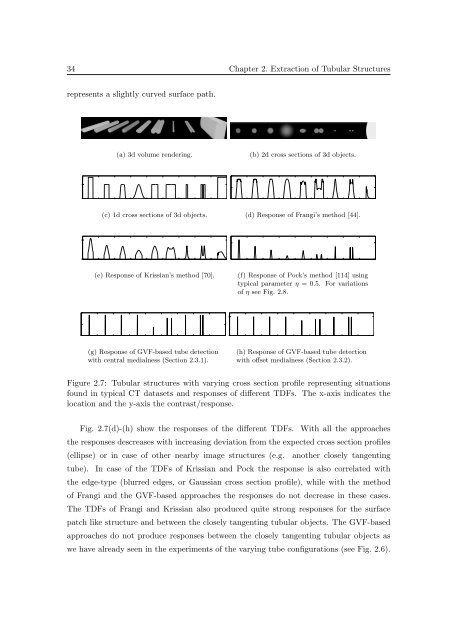Segmentation of 3D Tubular Tree Structures in Medical Images ...
Segmentation of 3D Tubular Tree Structures in Medical Images ...
Segmentation of 3D Tubular Tree Structures in Medical Images ...
Create successful ePaper yourself
Turn your PDF publications into a flip-book with our unique Google optimized e-Paper software.
34 Chapter 2. Extraction <strong>of</strong> <strong>Tubular</strong> <strong>Structures</strong><br />
represents a slightly curved surface path.<br />
(a) 3d volume render<strong>in</strong>g.<br />
(b) 2d cross sections <strong>of</strong> 3d objects.<br />
1000<br />
100<br />
500<br />
0<br />
0<br />
0 200 400 600 800 1000 1200 1400 1600 18000 200 400 600 800 1000 1200 1400 1600 1800<br />
(c) 1d cross sections <strong>of</strong> 3d objects.<br />
(d) Response <strong>of</strong> Frangi’s method [44].<br />
50<br />
50<br />
0<br />
0<br />
0 200 400 600 800 1000 1200 1400 1600 18000 200 400 600 800 1000 1200 1400 1600 1800<br />
(e) Response <strong>of</strong> Krissian’s method [70].<br />
(f) Response <strong>of</strong> Pock’s method [114] us<strong>in</strong>g<br />
typical parameter η = 0.5. For variations<br />
<strong>of</strong> η see Fig. 2.8.<br />
20<br />
10<br />
500<br />
0<br />
0<br />
0 200 400 600 800 1000 1200 1400 1600 18000 200 400 600 800 1000 1200 1400 1600 1800<br />
(g) Response <strong>of</strong> GVF-based tube detection<br />
with central medialness (Section 2.3.1).<br />
(h) Response <strong>of</strong> GVF-based tube detection<br />
with <strong>of</strong>fset medialness (Section 2.3.2).<br />
Figure 2.7: <strong>Tubular</strong> structures with vary<strong>in</strong>g cross section pr<strong>of</strong>ile represent<strong>in</strong>g situations<br />
found <strong>in</strong> typical CT datasets and responses <strong>of</strong> different TDFs. The x-axis <strong>in</strong>dicates the<br />
location and the y-axis the contrast/response.<br />
Fig. 2.7(d)-(h) show the responses <strong>of</strong> the different TDFs. With all the approaches<br />
the responses descreases with <strong>in</strong>creas<strong>in</strong>g deviation from the expected cross section pr<strong>of</strong>iles<br />
(ellipse) or <strong>in</strong> case <strong>of</strong> other nearby image structures (e.g. another closely tangent<strong>in</strong>g<br />
tube). In case <strong>of</strong> the TDFs <strong>of</strong> Krissian and Pock the response is also correlated with<br />
the edge-type (blurred edges, or Gaussian cross section pr<strong>of</strong>ile), while with the method<br />
<strong>of</strong> Frangi and the GVF-based approaches the responses do not decrease <strong>in</strong> these cases.<br />
The TDFs <strong>of</strong> Frangi and Krissian also produced quite strong responses for the surface<br />
patch like structure and between the closely tangent<strong>in</strong>g tubular objects. The GVF-based<br />
approaches do not produce responses between the closely tangent<strong>in</strong>g tubular objects as<br />
we have already seen <strong>in</strong> the experiments <strong>of</strong> the vary<strong>in</strong>g tube configurations (see Fig. 2.6).















